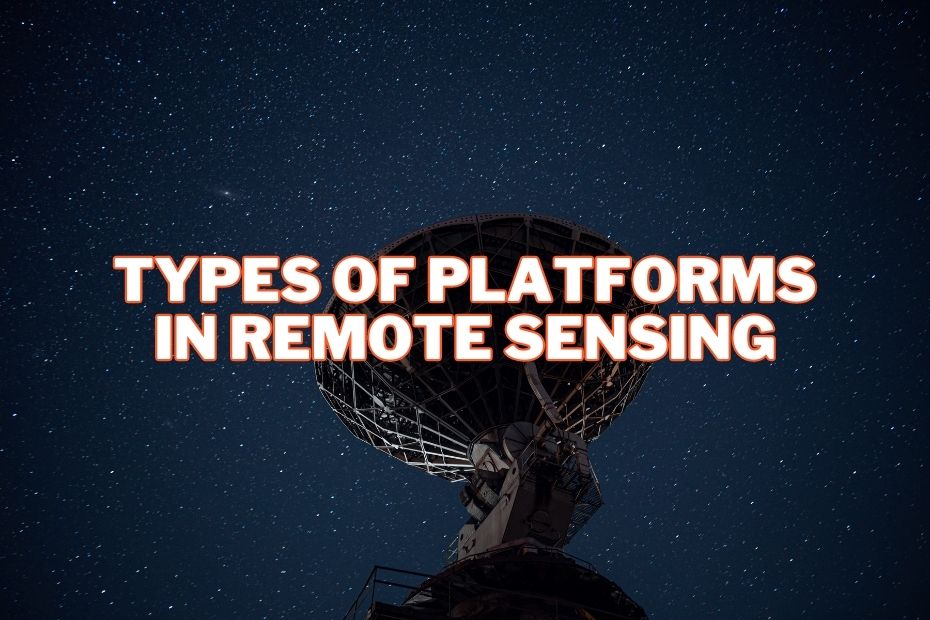Remote sensing platforms are the vehicles that carry remote sensors, allowing them to collect data from a distance. There are three main types of platforms in remote sensing, each with its unique characteristics and capabilities. In this article, we’ll take a closer look at these three types of platforms and their applications.
Remote sensing platforms include ground-based (tripods and towers), aerial (manned aircraft and unmanned aerial vehicles), and satellite platforms, which facilitate data collection from Earth’s surface, atmosphere, and oceans.
Different Types of Platforms In Remote Sensing
Remote sensing is a powerful tool used to acquire information about the Earth’s surface, atmosphere, and oceans without direct physical contact. This process relies on various carriers, known as platforms, sensors to capture and record data from a distance.
We will explore the different types of platforms in remote sensing, including ground-based, aerial, and satellite platforms, and their unique applications in monitoring and understanding our planet.
1. Airborne Platforms
Airborne platforms are remote sensing vehicles that operate in the Earth’s atmosphere. These include airplanes, helicopters, and drones. Airborne platforms are ideal for capturing high-resolution images and data over small areas. They are commonly used for aerial photography, surveying, and mapping. Airborne platforms can be further divided into two categories: manned and unmanned.
Manned Aircraft
Manned platforms are piloted aircraft that require a human operator. They are used for capturing high-quality imagery and data over large areas. Manned platforms are ideal for capturing aerial photographs for mapping purposes. They are also used for surveillance and reconnaissance.
Unmanned Aerial Vehicles (UAVs)
Unmanned aerial vehicles (UAVs), also known as drones, are becoming increasingly popular for remote sensing applications. UAVs can be used to capture high-resolution images and data at low altitudes, making them useful for a wide range of applications. UAVs are particularly useful for applications that require frequent monitoring or that involve hazardous or difficult-to-reach areas.
2. Ground Borne Platforms
Ground platforms are remote sensing vehicles that operate on the Earth’s surface. These include vehicles such as trucks, boats, and buoys. Ground platforms are used for capturing data from close proximity to the Earth’s surface. They are commonly used for monitoring soil moisture, ocean currents, and vegetation growth.
There are two main types of ground-based platforms: ground-based laser scanning (LiDAR) and terrestrial photogrammetry.
Ground-Based Laser Scanning (LiDAR)
Ground-based laser scanning, also known as LiDAR, is a remote sensing technique that uses laser pulses to measure distances between the sensor and the Earth’s surface. LiDAR can be used to create highly accurate 3D models of the Earth’s surface.
Terrestrial Photogrammetry
Terrestrial photogrammetry is a remote sensing technique that uses photographs taken from the ground to create 3D models of the Earth’s surface. Terrestrial photogrammetry can be used to create highly accurate models of the Earth’s surface, and can be used for a wide range of applications, including land surveying, construction, and urban planning.
READ MORE: Lidar Vs Photogrammetry
3. Space Borne Platforms
Space platforms are remote sensing vehicles that operate in space. These include satellites, which are the most commonly used space platforms for remote sensing. Satellites are used for capturing data from a global perspective, allowing us to monitor changes in the Earth’s atmosphere, oceans, and land. They are also used for disaster management and national security.
Space platforms can be further divided into two categories: low-Earth orbit and geostationary orbit.
Low-Earth Orbit Platforms
Low-Earth orbit platforms are satellites that orbit the Earth at an altitude of less than 2000 km. They are used for capturing high-resolution imagery and data over small areas. Low-Earth orbit platforms are commonly used for monitoring weather patterns, tracking wildfires, and studying the Earth’s surface.
Geostationary Orbit Platforms
Geostationary orbit platforms are satellites that orbit the Earth at an altitude of approximately 36,000 km. They are used for capturing data from a global perspective, allowing us to monitor changes in the Earth’s atmosphere, oceans, and land. Geostationary orbit platforms are commonly used for weather forecasting and climate monitoring.
READ MORE: Geostationary vs Geosynchronous Satellite
Conclusion
Remote sensing platforms are essential tools in modern-day Earth observation. Each platform has its unique capabilities and characteristics, making it suitable for specific applications. Airborne platforms are ideal for capturing high-resolution imagery and data over small areas, ground platforms are used for capturing data from close proximity to the Earth’s surface, and space platforms are used for capturing data from a global perspective.
Understanding the different types of satellite platforms used for remote sensing is essential for choosing the appropriate platform for a given remote sensing application.
FAQs: Types of Platforms In Remote Sensing
What are the three types of remote sensing platforms?
The three types of remote sensing platforms are airborne, ground, and satellite platforms.
What is the difference between manned and unmanned airborne platforms?
Manned airborne platforms are piloted aircraft that require a human operator, while unmanned airborne platforms are remotely controlled aircraft, commonly referred to as drones.
